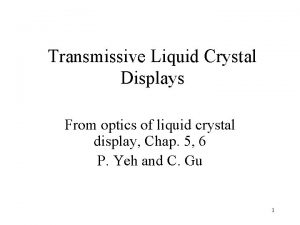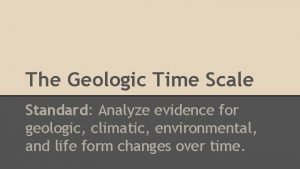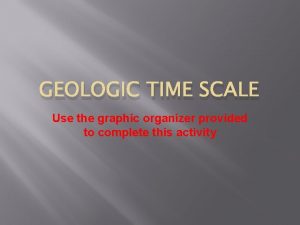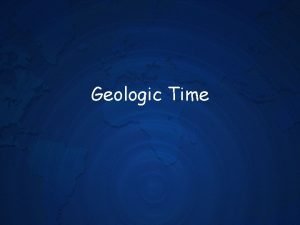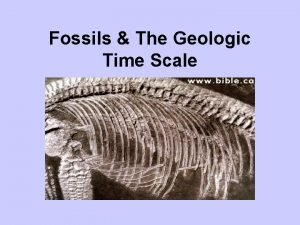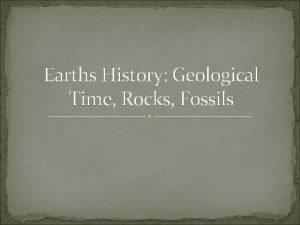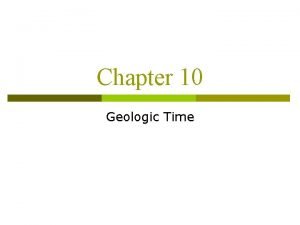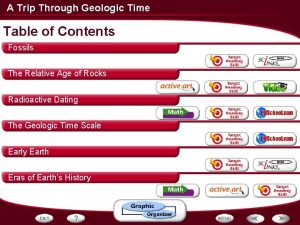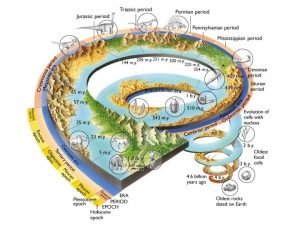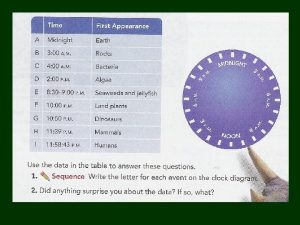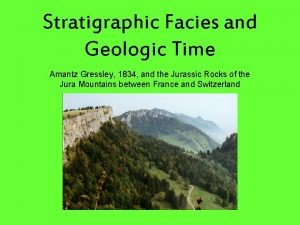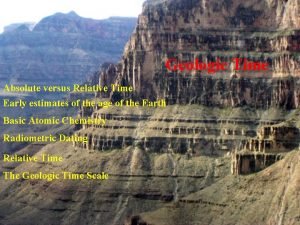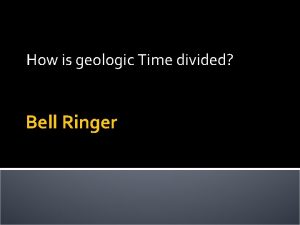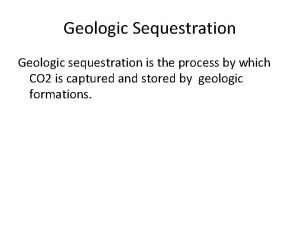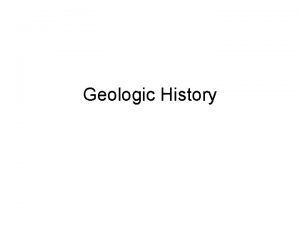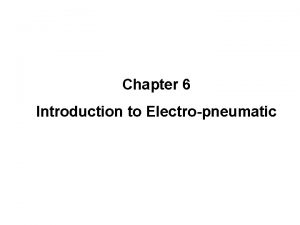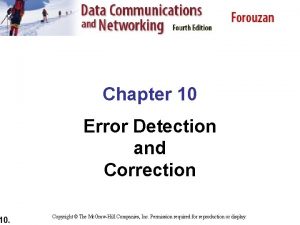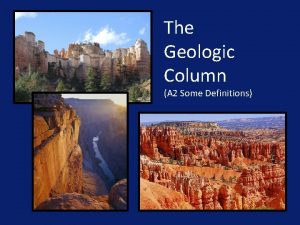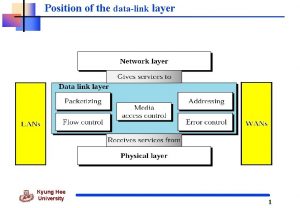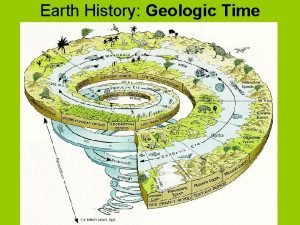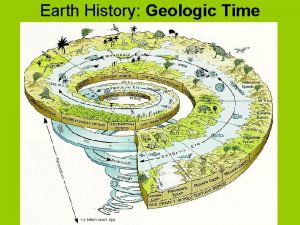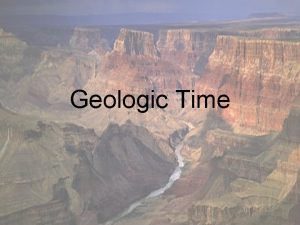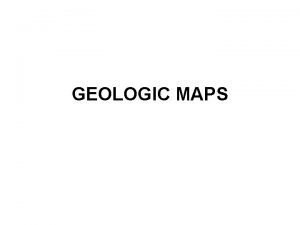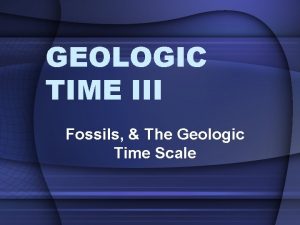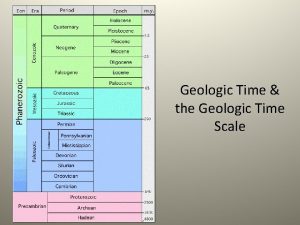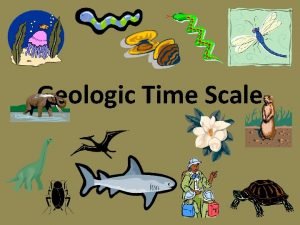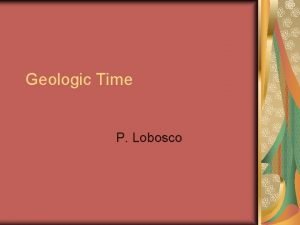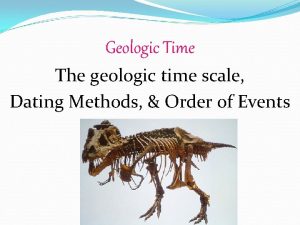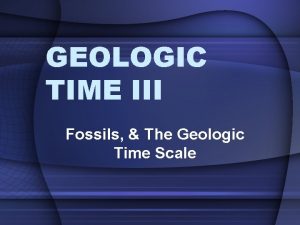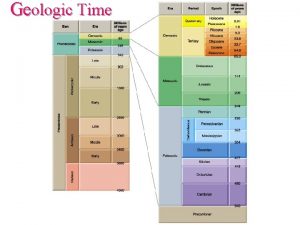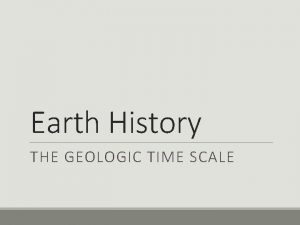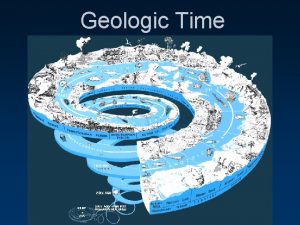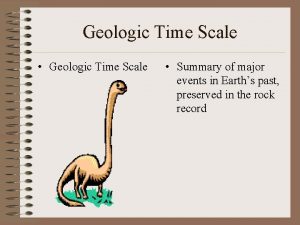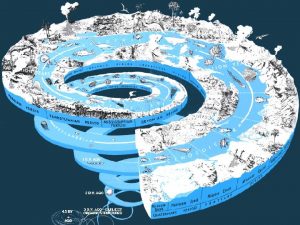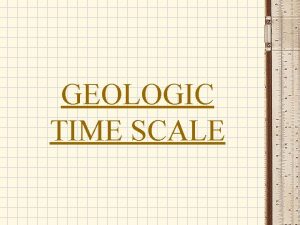UNIT 9 GEOLOGIC TIME GEOLOGIC TIME Normally we































- Slides: 31

UNIT - 9 GEOLOGIC TIME

GEOLOGIC TIME � Normally we think of time in terms of days or years but geologists commonly refer to events that happened millions or billions of years ago � For example earth is approximately 4. 6 billion years old

GEOLOGIC TIME � � Geologists measure geologic time in two different ways Relative Age and Absolute Age

GEOLOGIC TIME RELATIVE AGE � Determination of relative age is based on a simple principle: � In order for an event to affect a rock, the rock must exist first. Thus, the rock must be older than the event. FOLDED ROCKS

GEOLOGIC TIME ABSOLUTE AGE � Absolute age is age in years � Dinosaurs became extinct 65 million years ago

RELATIVE GEOLOGIC TIME 1: The principle of original horizontality � It is based on the fact that sediment usually accumulates in horizontal layers. � If sedimentary rocks lie at an angle, we can infer that tectonic forces tilted them after they formed

RELATIVE GEOLOGIC TIME 2: The principle of superposition � It states that sedimentary rocks become younger from bottom to top (as long as tectonic forces have not turned them upside down). � This is because younger layers of sediment always accumulate on top of older layers. In the figure below the sedimentary layers become progressively younger in the order E, D, C, B, and A.

RELATIVE GEOLOGIC TIME 3: The principle of cross-cutting relationships � It states that a rock must first exist before anything can happen to it. � The figure below shows sedimentary rocks intruded by three granite dikes. � Dike B cuts dike C, and dike A cuts dike B, so dike C is older than B, and dike A is the youngest. The sedimentary rocks must be older than all of the dikes.

RELATIVE GEOLOGIC TIME 4: The principle of unconformities � Layers of sedimentary rocks are conformable if they were deposited without interruption. An unconformity represents an interruption in deposition, usually of long duration. � During the interval when no sediment was deposited, some rock layers may have been eroded � Thus, an unconformity represents a long time interval for which no geologic record exists in that place. The lost record may involve hundreds of millions of years � There are several types of unconformities

UNCONFORMITIES Disconformity � In this case the sedimentary layers above and below the unconformity are parallel. � Geologists identify disconformities by determining the ages of rocks using methods based on fossils and absolute dating

UNCONFORMITIES Angular unconformity � In this case tectonic activity tilted older sedimentary rock layers before younger sediment accumulated

UNCONFORMITIES Nonconformity � In this case sedimentary rocks lie on igneous or metamorphic rocks

RELATIVE GEOLOGIC TIME 5: The principle of faunal succession It states that fossil organisms succeeded one another through time in a definite and recognizable order and that the relative ages of rocks can therefore be recognized from their fossils

RELATIVE GEOLOGIC TIME � Paleontologists study fossils, the remains and other traces of prehistoric life, to understand the history of life and evolution. � Fossils also provide information about the ages sedimentary rocks and their depositional environments of

FOSSILS AND FAUNAL SUCCESSION � The theory of evolution states that life forms have changed throughout geologic time. � Fossils are useful in determining relative ages of rocks because different animals and plants lived at different times in the Earth’s history. � For example, trilobites lived from 535 million to 245 million years ago, and the first dinosaurs appeared about 220 million years ago.

CORRELATION � To assemble a complete and continuous a record, geologists combine evidence from many localities. To do this, rocks of the same age from different localities must be matched in a process called correlation � There are two kinds of correlation Ø Time correlation and Ø Lithologic correlation

CORRELATION � Time correlation: matching of rocks deposited at the same time (e. g. Mesozoic sedimentary rocks in the U. S. with Mesozoic sedimentary rocks in Mexico) � Time correlation requires the use of index fossils to demonstrate rocks were deposited at the same time

CORRELATION � Index fossils are fossils used to define and identify geologic periods. � They work on the premise that, although different sediments may look different depending on the conditions under which they were laid down, they may include the remains of the same species of fossil.

CORRELATION � � � To be useful, an index fossil is produced by an organism that is abundantly preserved in rocks, was geographically widespread, existed as a species or genus for only a relatively short time, and is easily identified in the field.

EXAMPLES OF INDEX FOSSILS

CORRELATION � Lithologic correlation: matching rocks of the same character from one place to another. Usually it is not as accurate as time correlation, but easier � This doesn't require index fossils, but lithologic correlation may not correlate rocks deposited at the same time. � Lithologic correlation requires the use of key beds/marker beds

CORRELATION �A key bed/marker bed is a thin, widespread sedimentary layer that was deposited rapidly and synchronously over a wide area and is easily recognized � Examples eruptions are the ash deposits from volcanic

CORRELATION The K-T boundary layer which is marker bed found almost all over the world. The layer shows high concentration of the element iridium does not occur naturally on Earth in high concentrations, but it does occur in higher concentrations in certain types of meteorites. It points to a metorite impact 65 million years ago which was responsible for the extiction of the dinosaurs

ABSOLUTE GEOLOGIC TIME � Natural Radioactivity of the elements present in rocks provides a way for measuring the absolute geologic time • Elements having the same atomic number but different atomic mass are known as Isotopes • The difference in mass is due to the difference in the number of neutrons

ABSOLUTE GEOLOGIC TIME � Many isotopes are stable and do not change with time. For example potassium-39 remains unchanged even after 10 billion years • Other isotopes are unstable or radioactive. Given time, their nuclei spontaneously break apart • Potassium-40 decomposes naturally to form two other isotopes, argon-40 and calcium 40

ABSOLUTE GEOLOGIC TIME �A radioactive isotope such as potassium-40 is known as a parent isotope. � An isotope created by radioactivity, such as argon-40 or calcium-40, is called a daughter isotope.

ABSOLUTE GEOLOGIC TIME � The half-life is the time it takes for half of the atoms in a sample to decompose. • The half-life of potassium- 40 is 1. 3 billion years. Therefore, if 1 gram of potassium-40 were placed in a container, 0. 5 gram would remain after 1. 3 billion years, 0. 25 gram after 2. 6 billion years, and so on. Each radioactive isotope has its own half-life; some half-lives are fractions of a second and others are measured in billions of years.

ABSOLUTE GEOLOGIC TIME � Two aspects of radioactivity are essential to the calendars in rocks � First, the half-life of a radioactive isotope is constant. It is easily measured in the laboratory and is unaffected by geologic processes. So radioactive decay occurs at a known, constant rate � Secondly as a parent isotope decays, its daughter accumulates in the rock. The longer the rock exists, the more daughter isotope accumulates. The accumulation of a daughter isotope is similar to marking off days on a calendar

ABSOLUTE GEOLOGIC TIME

ABSOLUTE GEOLOGIC TIME � Radiometric dating is the process of determining the ages of rocks, minerals, and fossils by measuring their parent and daughter isotopes • At the end of one half-life, 50 percent of the parent atoms have decayed to daughter. • At the end of two half-lives, the mixture is 25 percent parent and 75 percent daughter. • To determine the age of a rock, a geologist measures the proportions of parent and daughter isotopes in a sample and compares the ratio.

THE GEOLOGICAL COLUMN AND TIME SCALE • The largest time units are eons, which are divided into eras. • Eras are subdivided, in turn, into periods, which are further subdivided into epochs • The Phanerozoic Eon is finely and accurately subdivided because sedimentary rocks deposited at this time are often well preserved and they contain abundant wellpreserved fossils • In contrast, Precambrian rocks and time are only coarsely subdivided because fossils are scarce and poorly preserved and the rocks are often altered.
 Compare geologic time with the geologic column.
Compare geologic time with the geologic column. Normally white vs. normally black
Normally white vs. normally black How is the geologic time scale organized
How is the geologic time scale organized Graphic organizer of geologic time scale
Graphic organizer of geologic time scale Geologic time scale in a calendar year
Geologic time scale in a calendar year Geologic time scale animals
Geologic time scale animals Fossils
Fossils Geologic time scale drawing
Geologic time scale drawing A trip through geologic time answer key
A trip through geologic time answer key Eon division
Eon division Geologic time scale drawing
Geologic time scale drawing Geologic time scale
Geologic time scale Geologic time
Geologic time Geologic time scale
Geologic time scale Silurian period
Silurian period Geologic time scale
Geologic time scale What is the longest subdivision in geologic time
What is the longest subdivision in geologic time Geologic time scale drawing
Geologic time scale drawing Chapter 12 geologic time
Chapter 12 geologic time Unit 6 review questions
Unit 6 review questions What do you usually do at weekends?
What do you usually do at weekends? Timers in plc
Timers in plc Geologic sequestration
Geologic sequestration Definition of geologic history
Definition of geologic history Components of electro pneumatic system
Components of electro pneumatic system Soil bearing capacity
Soil bearing capacity The divisor in a cyclic code is normally called
The divisor in a cyclic code is normally called Geologic column definition
Geologic column definition Detent switch normally open
Detent switch normally open Bottle gum method
Bottle gum method Muscarinic adrenergic receptors
Muscarinic adrenergic receptors The divisor in a cyclic code is normally called as
The divisor in a cyclic code is normally called as

